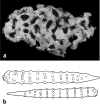A new species of Agelas from the Zanzibar Archipelago, western Indian Ocean (Porifera, Demospongiae)
- PMID: 26877669
- PMCID: PMC4740978
- DOI: 10.3897/zookeys.553.5999
A new species of Agelas from the Zanzibar Archipelago, western Indian Ocean (Porifera, Demospongiae)
Abstract
A new sponge species (Demospongiae: Agelasida: Agelasidae) is described from the eastern coast of Unguja Island in the Zanzibar Archipelago. Agelas sansibarica sp. n. is compared to all other Agelas species described so far. The new species differs from its congeners mainly in its three categories of verticillate spicules (acanthostyles, acanthostrongyles, and acanthoxeas) and their sizes. Acanthostrongyles, well represented in the spicular complement, are an exclusive trait of the new species widening the morphological range of the genus. Summarizing on spicular complement and spicular morphotraits of 36 species belonging to the genus Agelas: i) 32 species show only acanthostyles from Indo-Pacific (n = 14), Atlantic (n = 17), and Mediterranean (n = 1); ii) three Indo-Pacific species show acanthostyles and acanthoxeas; iii) one species Agelas sansibarica sp. n. from the western Indian Ocean is characterised by the unique trait of three categories of verticillate spicules (acanthostyles, acanthostrongyles and acanthoxeas). A key for the Indo-Pacific species is supplied together with short descriptions, illustrations, and geographic range; literature on chemical bioprospecting of the genus Agelas is also provided.
Keywords: Biodiversity; Unguja Island; diagnostic key; geographic range; morpho-taxonomy; sponges.
Figures





















Similar articles
-
Description of three species of Eurypon Gray, 1867 (Raspailiidae: Demospongiae: Porifera) from the Western Atlantic and a name to replace the the secondary homonym Eurypon topsenti.Zootaxa. 2018 Feb 28;4388(1):89-101. doi: 10.11646/zootaxa.4388.1.6. Zootaxa. 2018. PMID: 29690466
-
The genus Corvospongilla Annandale, 1911 (Porifera: Demospongiae: Spongillida) from Madagascar freshwater with description of a new species: biogeographic and evolutionary aspects.Zootaxa. 2019 May 31;4612(4):zootaxa.4612.4.6. doi: 10.11646/zootaxa.4612.4.6. Zootaxa. 2019. PMID: 31717042
-
Reef sponges of the genus Agelas (Porifera: Demospongiae) from the Greater Caribbean.Zootaxa. 2014 May 7;3794:301-43. doi: 10.11646/zootaxa.3794.3.1. Zootaxa. 2014. PMID: 24870328
-
Review of the Acanthopagrus latus complex (Perciformes: Sparidae) with descriptions of three new species from the Indo-West Pacific Ocean.J Fish Biol. 2013 Jul;83(1):64-95. doi: 10.1111/jfb.12151. Epub 2013 Jun 17. J Fish Biol. 2013. PMID: 23808693 Review.
-
Taxonomy of the Genus Halophila Thouars (Hydocharitaceae): A Review.Plants (Basel). 2020 Dec 8;9(12):1732. doi: 10.3390/plants9121732. Plants (Basel). 2020. PMID: 33302504 Free PMC article. Review.
Cited by
-
Secondary metabolites from marine sponges of the genus Agelas: a comprehensive update insight on structural diversity and bioactivity.RSC Adv. 2022 Mar 9;12(13):7789-7820. doi: 10.1039/d1ra08765g. eCollection 2022 Mar 8. RSC Adv. 2022. PMID: 35424773 Free PMC article. Review.
-
Antimicrobial Diterpene Alkaloids from an Agelas citrina Sponge Collected in the Yucatán Peninsula.Mar Drugs. 2022 Apr 28;20(5):298. doi: 10.3390/md20050298. Mar Drugs. 2022. PMID: 35621949 Free PMC article.
-
Voltage-Gated K+ Channel Modulation by Marine Toxins: Pharmacological Innovations and Therapeutic Opportunities.Mar Drugs. 2024 Jul 29;22(8):350. doi: 10.3390/md22080350. Mar Drugs. 2024. PMID: 39195466 Free PMC article. Review.
References
-
- Assmann M, Köck M. (2002) Bromosceptrin, an alkaloid from the marine sponge Agelas conifera. Zeitschrift fur Naturforschung 57c: 157–160. doi: 10.1515/znc-2002-1-226 - DOI - PubMed
-
- Assmann M, Lichte E, Pawlik JR, Köck M. (2000) Chemical defenses of the Caribbean sponges Agelas wiedenmayeri and Agelas conifera. Marine Ecology Progress Series 207: 255–262. doi: 10.3354/meps207255 - DOI
-
- Assmann M, Zea S, Köck M. (2001) Sventrin, a new bromopyrrole alkaloid from the Caribbean sponge Agelas sventres. Journal of Natural Products 64: 1593–1595. doi: 10.1021/np010350e - DOI - PubMed
-
- Assmann M, Lichte E, Köck M. (2004) Multiple defensive roles for bromopyrrole alkaloids from Caribbean Agelas sponges. In: Pansini M, Pronzato R, Bavestrello G, Manconi R. (Eds) Sponge Sciences in the New Millennium, Bollettino dei Musei e degli Istituti Biologici dell‘Università di Genova 68: 187–193.
-
- Baer L. (1906) Silicospongien von Sansibar, Kapstadt und Papeete. Archiv fur Naturgeschichte 72: 1–32, pl. i–v.
LinkOut - more resources
Full Text Sources
Other Literature Sources
Research Materials
